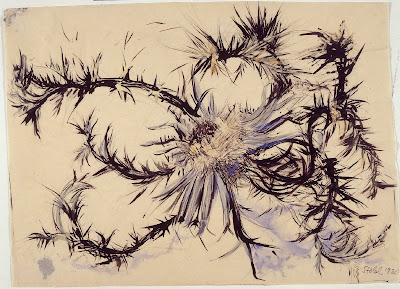five choirs, jacquered weave in cotton, wool, rayon and silk, 1928
design for a wall hanging, bauhaus dessau, 1927/28
christmas card for maud grote, 1930
watercolor, trude hantschg-arndt, 1926
design for a fabric, 1960s
african or romantic chair by marcel breuer with textile by gunta stölzl, 1921
water-color, signed gunda weihnachten, 1919
cows in landscape
stölzl wove her first wall-hanging during the summer vacation in 1920.
gobelin technique, in part slit formation - warp: cotton. weft: wool & fine mohair
detail of design for "slit tapestry red-green", 1927/28
wall hanging, "slit tapestry red-green", 1927/1928
double (front/back) watercolour for a textile, bauhaus weimer
watercolor and pen-and-ink, painted during summer holiday trip to south of france
inscribed on reverse side: 1927 st. jean de luce
design for a toy animal made of fabric, 1920
thistle
preliminary course under johannes itten, bauhaus weimar, 1921
untitled, 1921
shoulder bag produced for the swiss national exhibition held in zurich in 1939.
motif is the national flag - swiss cross - and forms the main pattern of bag while the borders reflect the colors of the city standard.
decorative fabric, mohair, 1964
bergzabern, gouache, 1931
painted box, oil paint on plywood, 1919/1920
gunta stölzl
gunta stölzl (5 march 1897 - 22 april 1983) was a german textile artist. who played a fundamental role in the development of the bauhaus school's weaving workshop. as the bauhaus's only female master she created enormous change within the weaving department. she joined the bauhaus as a student in 1920 at the age of 23, became a junior master in 1927 & a full master the next year. she was dismissed for political reasons in 1931, a year before the bauhaus closed under pressure from the nazis.
the textile department was a neglected part of the bauhaus when stölzl began her career, and its active masters were weak on the technical aspects of textile production. she soon became a mentor to other students and re-opened the bauhaus dye studios in 1921. after a brief departure, she became the school's weaving director in 1925 when it relocated from weimer to dessau & expanded the department to increase its weaving & dyeing facilities. she applied ideas from modern art to weaving, experimented with synthetic materials & improved the department's technical instruction to include courses in mathematics. the bauhaus weaving workshop became one of its most successful facilities under her direction.










+watercolour+for+a+textile,+bauhaus+weimer.jpg)












LOVE!!!
ReplyDelete